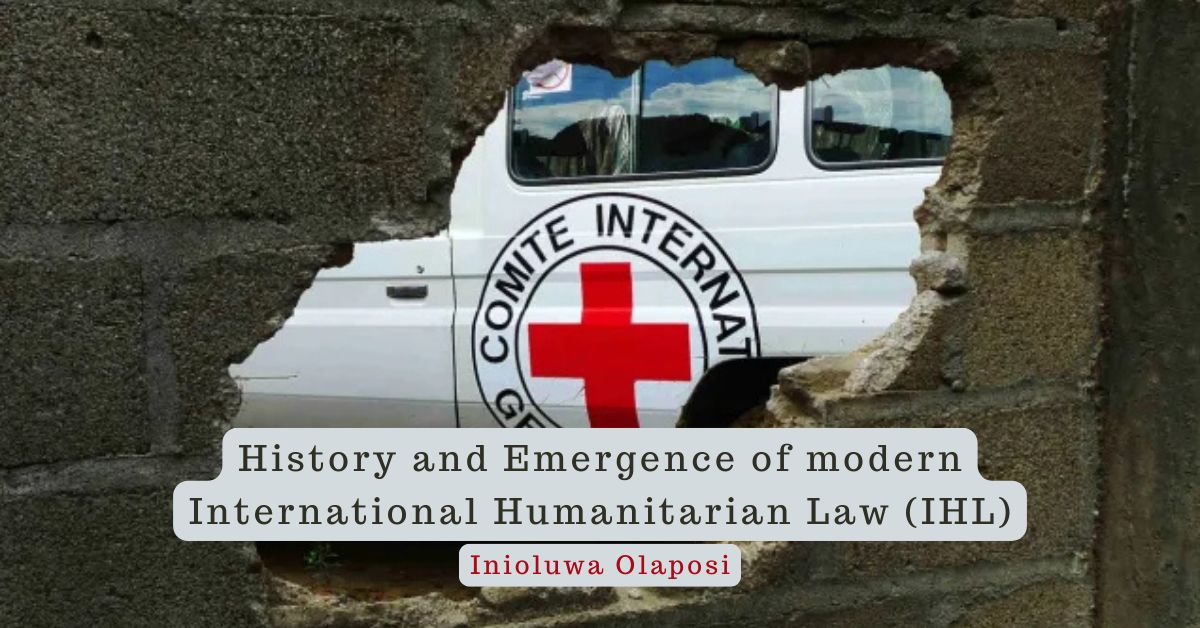The History and Emergence of modern IHL
International Humanitarian Law has an ancient history that can be traced to diverse historical practices and documents.
Many ancient societies had their own customs for conducting war, including the Papuans, Persians, Sumerians, Greeks, and Romans. For example, the Indian epic Mahabharata (c. 400 BC) prohibited killing a surrendered adversary, and the Laws of Manu forbade the use of certain weapons.
Also, other ancient documents, including the Bible and the Koran, contain rules promoting respect for the other party in conflict. In 2 Kings 6:22, for example, Prophet Elisha instructs the King of Israel concerning some captured Syrian soldiers, saying:
“You shall not kill them. Would you kill those whom you have taken captive with your sword and your bow? Set food and water before them, that they may eat and drink and go to their master.”
However, modern IHL can be traced to one man – Henry Dunant. Dunant is an inevitable name in the study of the history of IHL.
Henry Dunant and the Battle of Solferino
Henry Dunant was a Swiss businessman. While travelling in Italy in 1859, he experienced the grievous fate of wounded soldiers in the Battle of Solferino. The Battle of Solferino was a decisive battle in the Italian War of Independence that took place on June 24, 1859. The battle was fought between Austrian forces and a Franco-Piedmontese army.
During the Battle of Solferino, around 30,000 soldiers were killed and many thousands more were wounded. Thousands of these soldiers were left on the battlefield with no one to care for them. Apparently, the medical services provided by these armies were inadequate to cater for the need of the wounded soldiers.
Henry Dunant was touched by the sight of the suffering soldiers and he set out to help them. He mobilized the local population to set up infirmaries and provide food, water, and medical treatment. He also organized women from Castiglione delle Stiviere1 to provide first aid and care to the wounded. The care offered to the soldiers was without regard to their side in the conflict.
The Aftermath: A Memory of Solferino
After his experience at the Battle of Solferino, Dunant made a vivid documentation of the horrors of the battle and his ideas in a book. The book was titled ‘A Memory of Solferino’. Published in 1862, A Memory of Solferino contained three major appeals by Dunant.
- Formation of National relief societies consisting of volunteers that are ready and able to care for the wounded.
- Creation of an international relief society to support the efforts of these societies.
- Adoption of an International Agreement to guarantee recognition and respect for the volunteers and protect the wounded.
The suggestions made by Dunant led to the formation of the Red Cross Movement, as well as the creation of the Geneva conventions.
Others: General Dufour
Guillaume-Henri Dufour is another personality that participated heavily in the creation of the International Committee of the Red Cross (ICRC) and the development of international humanitarian law (IHL).
In 1863, Dunant and Dufour formed the ‘Committee of Five’, an international committee to provide relief for wounded soldiers. Other members of the committee were Gustave Moynier, Louis Appia, and Théodore Maunoir. The committee became the International Committee of the Red Cross in 1876.
General Dufour lent his active support to Dunant’s ideas and chaired the 1864 diplomatic conference. The 1864 conference was convened by the Swiss government at the prompting of the ‘Committee of Five’ and attended by 16 States. The first Geneva Convention was adopted in the conference. It was known as the Geneva Convention for the Amelioration of the Condition of the Wounded in Armies in the Field, and served as the birth of modern IHL.
The Four Geneva Conventions and Additional Protocols
The four Geneva Conventions and their Additional Protocols remain at the cornerstone of IHL till date.
The 1864 Geneva Convention was revised in 1906 and 1929. Another convention for the protection of Prisoners of War was adopted in 1929. After the Second World War, the Four Geneva Conventions were adopted in the Geneva Diplomatic Conference of 1949.
Sixty-three governmental delegations attended the 1949 Geneva Conference, which took place between April and August of that year. The four Geneva Conventions and their focus can be highlighted as follows:
- the Convention for the Amelioration of the Condition of the Wounded and Sick in Armed Forces in the Field.
- the Convention for the Amelioration of the Condition of the Wounded, Sick, and Shipwrecked Members of Armed Forces at Sea.
- the Convention Relative to the Treatment of Prisoners of War, and
- the Convention Relative to the Protection of Civilian Persons in Time of War.
The Additional Protocols to the Geneva Conventions of 1949 were adopted to strengthen the protection of victims of armed conflict and to limit the conduct of war. The first two additional protocols were adopted on 8 June 1977.
The Additional Protocols combine both protections afforded to victims of armed conflict (‘law of Geneva’) and measures regulating right and obligations of combatants, as well as limitation on the means and method of warfare (‘law of The Hague’).
A third additional protocol was adopted in 2005. This protocol provides for an additional emblem to be used by humanitarian bodies known as the ‘Red Crystal’. The Red Crystal can be used in place of the Red Cross or Red Crescent symbols during wartime.
Image Credit: ICRC
About Author
Inioluwa Olaposi is a recent graduate of Obafemi Awolowo University, Ile-Ife. He was part of a team of three that won the National International Humanitarian Law Moot Competition for Nigerian Universities and subsequently participated in the All-Africa Regional Rounds at Nairobi, Kenya.

- Town in the province of Mantua, in Lombardy, Italy. [↩]


Leave a Reply